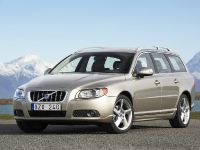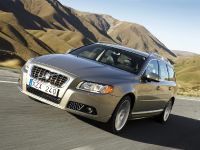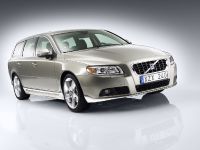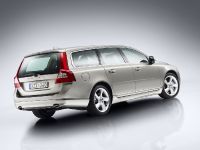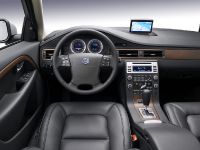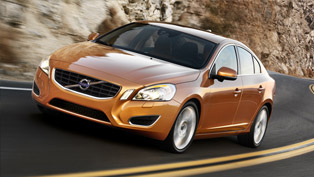Volvo V70
The all-new Volvo V70 is the third generation of Volvo's best-selling estate car. The all-new V70 model offers more of everything; it is more luxurious inside than its predecessor, it is sportier to drive, offers more space for both passengers and luggage, and it integrates a variety of intelligent solutions for flexible usage. Safety is at the highest level and the car also includes a world breakthrough – for the benefit of families with young children."With the all-new Volvo V70, we want to mark our position in the premium segment even more clearly than before," says Tomas Ahlborg, Project Director for the all-new V70. "We have seen that estate cars in the upper segment follow the same trend as sedans, that is to say a shift towards more specialised products. We have therefore focused firmly on giving the all-new Volvo V70 just about all the best features. Design, naturally, but we've also given top priority to areas such as driving pleasure, flexible function and high comfort – of course alongside safety, both preventive and protective. We know that all these properties are important to Volvo's customers, who in many cases are highly aware and active families."
1. Improved child safety with a world innovation
"When we developed the all-new Volvo V70 the aim was that it should be the safest car in its segment," says Ingrid Skogsmo, Director of Volvo Cars Safety Centre. "The V70 model shares the same sophisticated network of interacting safety systems as the Volvo S80. The patented body structure absorbs energy in a highly efficient way. And the interior safety system includes the latest generation of side airbags and whiplash protection. What is more, we are introducing a world innovation in the field of child safety."
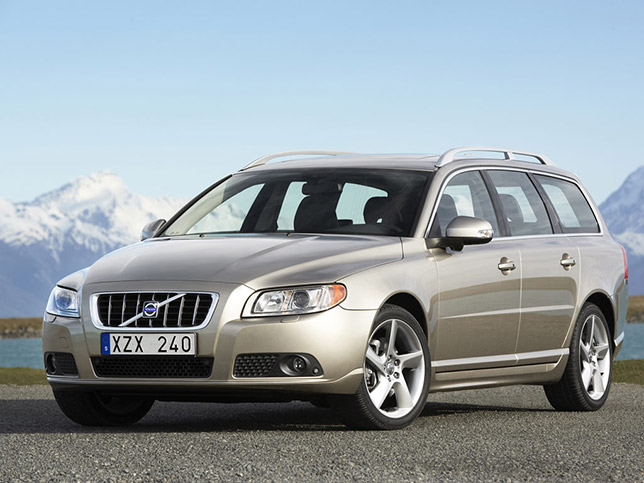
Improved child safety with extended IC (Inflatable Curtain) and integrated booster cushions – a world breakthrough
To improve safety for children in the rear seat of the all-new V70 model, Volvo has further developed the Side Impact Protection System (SIPS) with a stronger body structure, extended inflatable curtains and a height-adjustable integrated child booster cushion – the latter a world innovation.
The booster cushion, which is integrated in the rear seat, can be set at two heights, allowing children of different sizes to sit sufficiently high to see out through the windows yet at the same time get the most effective protection possible. The lower setting is intended for children between 115 and 140 cm in height and weighing between 22 and 36 kg, while the upper setting is designed for children measuring 95-120 cm and weighing between 15 and 25 kg. The all-new Volvo V70 can be equipped with integrated child booster cushions in both outer rear seats. The adjustable booster cushion means the seat belt geometry is optimum irrespective of the child's height. The integrated booster cushion is also accompanied by safety belts with specially adjusted force limiters. They contribute to the best possible protective effect by restraining the child with just the right amount of tensioning force in a collision.
The inflatable curtains in the all-new Volvo V70 have been extended by 60 mm, which in combination with the height-adjustable booster cushions and the strong body side structure provide more children of different sizes with effective protection in a side impact. Furthermore, the fact that more children are provided with comfortable seating on booster cushions helps create a more harmonious atmosphere in the car and provides better conditions for relaxed driving. The front passenger airbag can be disabled using a key. What is more, the seat can be specified with attachments for rear-facing fitting of a child seat once the front passenger airbag is disabled.
New, stronger side structure To optimise side-impact protection in the all-new V70 model, not only for children but for all occupants, the body's entire side structure is both stronger and lighter thanks to a well-balanced combination of high-tensile steel of different grades (High Strength Steel, Extra High Strength Steel and the extremely strong Ultra High Strength Steel). The various components and grades of steel interact to minimise penetration into the passenger compartment. The aim is instead to get the entire car to move sideways – away from the colliding vehicle.
The new type of side-impact airbag which was launched together with the all-new S80 model makes Volvo's patented SIPS (Side Impact Protection System) into an even more effective safety system. The new side impact airbags have two separate chambers – one for the hip section and one for the chest. Since the hips can withstand greater force than the chest can, the lower chamber inflates with up to five times more pressure than the upper section. The side-impact airbags interact with the inflatable curtains and the body's network of safety beams to provide the most effective protection.
Crumple zones made using different grades of steel The patented front body structure in the all-new Volvo V70 is divided into zones, each of which has a different task during the deformation sequence. The outer zones are responsible for most of the deformation. The closer the collision forces get to the passenger compartment, the less the material deforms. In order to give each zone the right properties, different grades of steel are used in different structures, a total of four different grades. Apart from regular body steel, three different grades of high-tensile steel are used: High Strength Steel, Extra High Strength Steel and Ultra High Strength Steel."With the zone system, we can exploit the material's properties to the very maximum for the best possible energy absorption," explains Ingrid Skogsmo. "The aim is that the passenger compartment should be preserved in a predictable way in a variety of collision scenarios."
ZONE FOR DEFORMATION AT LOW SPEEDS The front bumper is structured around a cross-member made of aluminium. The attachment points at the body's longitudinal beams are designed as collapsible "crash boxes". They help absorb incoming low-speed collision forces without damaging the rest of the body's beam structure.
ZONE FOR DEFORMATION AT HIGH SPEEDS The straight sections of the longitudinal beams are made of High Strength Steel, a very tough grade of steel that is optimised for high energy absorption. This zone accounts for most of the deformation.
ZONE FOR BACKUP The beam section that curves out towards the A-posts serves as a barrier protecting the passenger compartment and also as a backup to reduce deformation. Its shape also helps minimise the risk of the front wheel penetrating into the passenger compartment. Instead, the wheel helps absorb the collision forces. This section is very rigid and is made of Extra High Strength Steel.
THREE-POINT ATTACHMENT A rigid cross-member links the two A-posts and the lower side-members so that they form a particularly sturdy three-point attachment on each side. This design is particularly effective at protecting the passenger compartment in a severe impact.
Compact transverse engines contribute to collision safety Like the other models in the Volvo range, the all-new Volvo V70 has a transverse driveline and front-wheel drive. Transverse installation gives the engine more space inside the engine compartment and helps reduce the risk of penetration into the passenger compartment in a frontal impact. Even the six-cylinder engines have been able to be installed transversely in the all-new V70 model thanks to its extremely compact format and efficient packaging in the engine compartment.
Second-generation WHIPS system Volvo's system for avoiding neck injuries – WHIPS (Whiplash Protection System) – is one of the most effective on the market. In the event of a rear-end collision the front seat backrest accompanies the passenger's initial body movement and dampens the incoming force rather like one's hand does when catching a ball. The all-new Volvo V70 features the same generation of WHIPS mechanism as was launched on the all-new S80 model. This generation was further developed to ensure that the damping motion is gentle and to provide good contact between the head and head restraint throughout the impact sequence.
Protection for other road users Protection for pedestrians and cyclists has also been further developed in the all-new Volvo V70. The front has been given energy-absorbing properties, not least with a generously dimensioned soft structure in front of the bumper that helps reduce the risk of leg injuries. In addition, the spoiler's lower edge has been reinforced and moved forward, almost on a level with the bumper. The aim is that the area of contact on a pedestrian's or cyclist's leg should be distributed across a larger area, thus helping reduce the risk of injury still further. The bonnet is raised and its underside has a honeycomb structure which similarly spreads the load in the event of an impact, thus helping to absorb the energy and reduce the risk of personal injury.
2. Advanced drive systems contribute to increased safety margins
"The best way to protect the car's occupants is to avoid accidents," says Ingrid Skogsmo, Director of the Volvo Cars Safety Centre. "That's why we've developed a number of advanced driving and support systems that interact intelligently to assist the driver in difficult situations, yet without taking over the driving itself or taking over responsibility for safe progress. The task is to assist the driver to take the right decisions, by alerting him or her and in various ways indicating how best to get out of the situation."
Collision warning with brake support and emergency brake lights Rear-end collisions are a common type of accident. In many of these cases, the reason is that the driver is distracted and fails to respond in time. Against this background, Volvo Cars has developed a system known as Collision Warning with Brake Support. It is an advanced system with auxiliary functions that aim to avoid rear-end impacts or to minimise their consequences should they nevertheless occur.
The area in front of the car is continuously monitored with the help of a radar sensor. The system is activated in a variety of ways at different stages of the sequence: If the car approaches another vehicle from the rear and the driver does not react, a red warning lamp flashes in the windscreen. At the same time, a warning buzzer sounds. In certain situations this is enough for the driver to respond and take action to avoid the danger.
If the risk of a collision increases despite the warning, the brake support system is activated. In order to shorten the reaction time, the brakes are prepared for action by automatic application of the pads against the discs. In addition, brake pressure is amplified hydraulically, which results in good braking effect even if the driver does not press particularly hard on the brake pedal.
"If the road speed is not too high, brake support helps reduce the consequences of a collision," says Ingrid Skogsmo. "However, it is always the driver's reactions that are crucial to the outcome." The application of firm braking is signalled to traffic behind the car by the brake lights first flashing (valid for Europe – fixed light for US markets). Once speed drops to below 30 km/h, the hazard warning flashers are also activated. In order to adapt the warning system to different conditions and individual driving styles, the system's sensitivity can be adjusted in the car's setup menu. There is a choice of three settings.
Adaptive cruise control In order to help the driver stay a safe distance behind the vehicle in front, Volvo Cars has developed Adaptive Cruise Control (ACC). This system should primarily be regarded as a comfort function but it does also contribute to more controlled progress if the rhythm of traffic is uneven. The technology is also used as a basis for several of Volvo's advanced driving and support systems. Using a radar sensor, the adaptive cruise control continually monitors the gap to the vehicles in front and automatically adjusts the car's speed to ensure that this gap does not shrink too much. The driver activates the cruise control by setting a desired speed between 30 and 200 km/h and then selecting the minimum time gap to the vehicles in front. There are five different time gaps to choose between.
Advanced information systems contribute to better driver control The all-new Volvo V70 is also equipped with BLIS (Blind Spot Information System) and IDIS (Intelligent Driver Information System), two systems that can help the driver maintain better control over the driving situation.
Using cameras integrated into the door mirrors, BLIS registers whether another vehicle is in the blind spot offset to the rear of the car. If there is a vehicle there, a lamp lights up at the relevant mirror to alert the driver and increase his or her chance of making the appropriate decision.
IDIS is an electronic information system that helps prevent the driver from becoming distracted by irrelevant information in busy situations. By continuously monitoring certain functions in the car such as steering wheel movements, the movement of the accelerator pedal, turn indicator usage and brake application, IDIS can assess the complexity of the current situation. The information is processed and at a certain level of complexity, any information that is not essential to safety is delayed, for instance incoming phone calls or SMS text messages.
Active Bi-Xenon Lights – swivelling headlamp beams In order to contribute to the best possible visibility during night-time driving on curving and twisting roads, the all-new Volvo V70 can be equipped with Active Bi-Xenon Lights – swivelling headlamps that follow the sweeps and bends of the road. A mini-processor is used to calculate and analyse a number of parameters and optimise the light beam to suit the situation. The headlamps can be swivelled up to 15 degrees in either direction, totalling 30 degrees, and can thus light up a longer stretch of road as it twists and turns. In order to save wear and tear on the system, it is automatically deactivated in daylight conditions. In order to lower the risk of dazzling oncoming traffic, the headlamps' height is adjusted depending on how heavily the car is loaded and also on whether the car is accelerating or braking. The headlamps are cleaned using an electromagnetic high-pressure system that washes one headlamp at a time so as to always provide the best possible illumination under all conditions.
Advanced, interacting braking functions The all-new Volvo V70 has a highly advanced braking system with a number of functions that interact to ensure the shortest possible braking distance under all circumstances.
HYDRAULIC BRAKE ASSIST (HBA) is a new generation of Volvo's emergency braking support system. It helps the driver to brake in the shortest possible distance in a panic situation. Unlike the previous system which was only based on vacuum, here brake pressure is also reinforced hydraulically. In an emergency situation where the driver does not press the brake pedal sufficiently quickly and firmly, HBA can help ensure that the ABS system is utilised optimally and the braking distance is reduced.
OPTIMIZED HYDRAULIC BRAKES (OHB) reinforce braking ability under hard braking by utilising hydraulics to compensate for low vacuum pressure in the brake servo.
READY ALERT BRAKES (RAB) can predict rapid braking and apply the brake pads against the discs even before the driver has time to press the brake pedal. The braking system's response time – and the braking distance – can thus be shortened. The triggering signal for the braking system may be that the accelerator pedal is released suddenly or that the adaptive cruise control registers an obstacle in front of the car.
FADING BRAKE SUPPORT (FBS) utilises the hydraulics to gradually build up braking pressure during long hard braking, thus helping cut the risk of brake fade and maintaining pedal feel.
Personal Car Communicator with heartbeat sensor provides enhanced security In an increasingly insecure world, it is important to have control over what happens in one's immediate vicinity, not least when you park your car. This is a matter both of preventing theft of and from the car and also of avoiding situations that may involve personal risks. Together with the all-new S80 model, Volvo Cars launched the Personal Car Communicator (PCC), an advanced pocket-sized control centre which is now also available on the all-new Volvo V70. The Personal Car Communicator provides information which in some circumstances may be crucial to the car owner's security and safety. The Personal Car Communicator is remarkably like a regular remote control but it can do a lot more than just activate the locks and alarm. A simple push of a button can within a few seconds tell the car owner if … … the car is locked or unlocked … … if the alarm has been triggered … … if the alarm has been triggered and someone is inside the car, which can be registered by a highly sensitive heartbeat sensor and an advanced calculation process. The information is available and up-to-date as long as the distance between the PCC and the car is about 100 metres or less. In addition, the most recent data is logged so the owner can at any time and any place check whether the car really was locked when it was parked.
Laminated glass all round and automatically locked storage unit in the luggage compartment In order to make break-ins more difficult, the all-new Volvo V70 can be specified with laminated glass in all the windows, including the rear side windows and the tailgate. This means that the luggage compartment too gets effective protection. The storage system under the luggage compartment floor has a capacity of no less than 46 litres if the car does not have a spare wheel, and it is now lockable. It is locked automatically and conveniently when the tailgate is closed and locked.
3. Upgraded driveline with more cylinders and new turbo technology
• Six-cylinder twin-scroll turbo engine offers an entirely new driving experience • Six-cylinder normally aspirated engine with dual cam profiles • Extremely compact transversely installed engines • Five-cylinder turbo engine with integrated turbocharger • Energy-efficient turbodiesel from second-generation D5 range • Wide engine range at the launch of the all-new Volvo V70 • FlexiFuel model powered by renewable bioethanol • Six-speed Geartronic with Sport mode
"The all-new Volvo V70 generation includes an upgrade of the engines too," says Tomas Ahlborg. "With more cylinders and new turbo technology, we now offer customers an even more thrilling performance experience allied to high-class ride comfort in one and the same package. It's a total experience that is premium in every single respect."
Six-cylinder twin-scroll turbo engine offers an entirely new driving experience For the first time ever, the Volvo V70 is now available with a six-cylinder performance engine. It is based on the immensely compact 3.2-litre in-line aluminium engine that was first launched in the all-new Volvo S80 in spring 2006. When fitted in the V70, it becomes available not just as a normally aspirated engine but also in a newly developed turbo version with a displacement of 3.0 litres, producing 210 kW (285 hp) and no less than 400 Nm of torque. Maximum torque is on tap from just 1500 rpm and remains available all the way up the rev range, resulting in remarkably quick acceleration and smooth driveability (0-100 km/h in 7,2 seconds - preliminary figure).
The somewhat smaller cylinder displacement of the turbo engine, owing to the slightly narrower cylinder bore and shorter stroke, is compensated by the turbocharger which in this engine takes in exhaust gases in two stages, with the inflow divided into two lots of three cylinders each, a system known as twin-scroll technology. Twin-scroll technology permits use of a more compact and uncomplicated turbocharger and provides extremely swift response, fully on a par with that from twin turbochargers. "This engine has been optimised to provide a particularly sporty driving experience and it gives the V70 concept an entirely new dimension," says Tomas Ahlborg. "We have what is virtually the perfect car for the active family, a car that also packs that little extra for the dedicated driving enthusiast. Yet at the same time, the engine has been programmed to provide the highest possible performance with the lowest possible fuel consumption and exhaust emissions."
Six-cylinder normally aspirated engine with dual cam profiles The six-cylinder normally aspirated engine producing 175 kW (238 hp) and 320 Nm offers a high-class driving experience. This engine has an advanced valve system with dual cam profiles on the inlet side. With CPS (Cam Profile Switching), as the system is known, the inlet valves can be lifted to two different heights in response to variations in engine revs and load. In normal driving, with normal throttle activation and low engine revs, fuel consumption is dampened at the same time as there is sufficient torque for good driveability. In sportier driving, under full acceleration and high revs, the engine is immensely alert to the throttle and powerful at both low and high speeds. "In principle two engines in one," explains Tomas Ahlborg, "satisfying both performance-orientated customers and those who prioritise driving comfort and fuel economy." In addition, the engine features VIS (Variable Intake System). It consists of two throttle valves that adjust the volume of the inlet manifold to suit the current driving conditions and allow the engine's capacity to be exploited to the very maximum throughout the rev range.
Extremely compact transversely installed engines As in the other Volvo models, all the engines are installed transversely, even the six-cylinder units. This has been made possible owing to an extremely compact construction. "A transversely mounted compact engine is the best way to reduce the risk of penetration into the passenger compartment in the event of a frontal collision, since the engine takes up minimal space in the car's longitudinal direction," explains Tomas Ahlborg. The six-cylinder in-line engine's compact format has been achieved by positioning ancillaries such as the power steering pump and air conditioning compressor behind the engine in the space above the gearbox. There is therefore no drive system for these ancillaries in front of the engine. Instead, drive is provided via gears on the rear of the crankshaft. This solution is called READ – Rear End Ancillary Drive. The alternator is direct-driven and is fitted onto the engine block. These solutions mean the entire package including the engine and gearbox take up the least possible space, above all in the car's longitudinal direction. By designing the drive system in the form of a small "gearbox" with an intermediary shaft inside the driveshaft – a solution known as Shaft In Shaft – the whole package has been able to be made very short. The two shafts are driven by different gears that give them different speeds (one speed for camshaft drive and one for powering the ancillaries). Even the vibration damper, which compensates for vibrations in the six-cylinder engine's relatively long crankshaft, has been integrated inside the engine block.
Five-cylinder turbo engine with integrated turbocharger There will also be a five-cylinder petrol engine as an alternative on the all-new Volvo V70. It is fitted with a light-pressure turbocharger and produces 147 kW (200 hp) and 300 Nm of torque. The engine is very compact, partly because the turbocharger is integrated into the manifold. It is made of high-quality steel that withstands high exhaust temperatures and contributes to efficient combustion and low exhaust emissions.
Energy-efficient turbodiesel from second-generation diesel range The all-new Volvo V70 can also be specified with Volvo's in-house manufactured second-generation D5 five-cylinder diesel engine. It is a very powerful and easy to drive turbodiesel which is available in two versions. The more powerful variant offers no less than 400 Nm of torque – and it does so across a particularly wide rev range. Compared with the first generation, the new D5 engine has been further developed and offers impressive refinement, featuring a new electronically controlled turbocharger, more advanced multi-point injection technology and a particularly powerful engine management system. The improvements have resulted in an entirely new driving experience with far higher performance and improved driveability. At the same time, emissions are noticeably lower. A service-free particle filter is standard, making the D5 a highly eco-efficient alternative. All the engines feature four valves per cylinder and double overhead camshafts, promoting alert response and good high-speed properties.
FlexiFuel model powered by renewable bioethanol FlexiFuel cars are run on E85, which is a blend of 85% renewable ethanol and 15% petrol. Ethanol is an entirely renewable fuel and can in principle be produced from just about any biomass source, such as corn, wheat, sugar-beet and cellulose. If the car is run on E85, emissions of fossil carbon dioxide, a greenhouse gas, drop by up to 80% compared with the same car running only on petrol. The all-new Volvo V70 will be available in an environmentally optimised FlexiFuel alternative. It is powered by a four-cylinder naturally aspirated engine producing 145 hp. Bioethanol and petrol are both filled in the same tank. The fuel hoses, valves and gaskets have all been modified to withstand the more corrosive properties of ethanol. The injection valves have been reinforced and are also larger, since more fuel is injected into the engine because of the lower energy content of E85 compared with petrol. Moreover, the software calibration is updated for ethanol power. The engine management system precisely monitors the fuel mixture in the fuel tank and automatically adjusts both injection and ignition to suit.
Six-speed Geartronic with Sport mode The five- and six-cylinder engines can be combined with a six-speed automatic Geartronic transmission. It is designed to handle the immense power of the most powerful turbo engines. With Geartronic it is also possible to change gear manually. For the T6 engine the six-speed Geartronic gearbox has a Sport mode which provides slightly faster gearshifts and a selection of a lower gear than in Drive mode. Sport mode is selected by moving the gear lever to the right in the Drive mode.
4. Dynamic chassis with advanced drive systems
• Advanced body structure and stable chassis promote controlled ride and roadholding properties • Active chassis with Four-C – and three settings • All Wheel Drive with Instant Traction • Adjustable power steering • Power Parking Brake is standard • DSTC is standard
"The all-new Volvo V70 has been further refined in every respect," says Tomas Ahlborg. "The chassis technology offers high-class driving feel and superb control whatever the situation. All of which helps us further reinforce Volvo's special position in the estate car premium segment."
Advanced body structure and stable chassis promote controlled ride and roadholding properties Not only the driveline but the whole of the car has been developed and balanced to give a first-class driving experience, based largely on pliant ride and secure roadholding allied to high stability. Stability is in fact particularly important when driving with many passengers and a lot of luggage. The body features a highly advanced structure that contributes to both good deformation properties in the event of a collision and to high torsional rigidity. Thanks to the design of the body structure and the optimised use of different grades of high-strength steel, torsional rigidity has been increased by no less than 15 percent compared to the previous V70 model. Good torsional rigidity is the very basis of the car's excellent ride and roadholding properties. The chassis technology has been further developed compared with the previous V70 model to provide even more stable and more controlled road manners. A lot of effort has also gone into features such as the suspension system and engine installation to ensure high-class comfort.
Active chassis with Four-C – and three choices The all-new Volvo V70 can be optionally specified with an active chassis based on Volvo's Four-C technology. It is an advanced self-regulating chassis system that uses a number of sensors to continuously monitor the car's behaviour. The dampers are adjusted to suit the current driving conditions in mere fractions of a second. Four-C adjusts chassis settings to match the car's speed. The higher the speed, the firmer the damping. This makes the car easy to control even at high speeds. This technology also reduces the car's tendency to squat, dip or yaw under hard acceleration, firm braking and quick steering wheel movements. "With an active chassis, the car's driving properties improve in all situations," says Tomas Ahborg. "It becomes both safer and more entertaining to drive."
Three alternative chassis settings at the touch of a button allow the driver to alter the car's driving character to suit his or her personal taste. • COMFORT provides pleasant, comfortable progress with calm, harmonious body movements. • SPORT provides more controlled body movements, faster steering response and a higher degree of road contact. • ADVANCED gives minimum damper movement and maximum contact between tyres and road surface. It's the setting for enthusiastic driving on smooth and flat asphalt.
In a difficult-to-control situation, however, the driver's choice makes no difference at all: Four-C always responds by helping the driver out of the situation by automatically stabilising the car to maintain control.
All Wheel Drive with Instant Traction The T6 model of the all-new Volvo V70 is equipped with Volvo's All Wheel Drive. Using an electronically controlled hydraulic clutch, the AWD system distributes drive between the front and rear wheels to ensure the best possible road grip in all situations. The system features Instant Traction, which shifts drive at lightning speed from the front to the rear wheels when starting on a slippery or loose surface.
Adjustable power steering Speed-dependent power steering is available as an option. The system delivers more servo assistance at low speeds, for instance to make things easier when parking. Servo assistance is reduced as speed rises, disappearing entirely at higher cruising speeds. In order to give every driver the most optimum road feedback, servo effect can be adjusted via the car's information and set-up system. Three levels of servo assistance are available.
Power Parking Brake is standard In order to assist the driver when starting on an uphill gradient, the all-new Volvo V70 has a smart, electrically operated parking brake system known as Power Parking Brake. This makes things far easier for the driver, especially if the car is fitted with a manual gearbox. If the parking brake is engaged at traffic lights, for instance, it is automatically disengaged when the accelerator is pressed and the car moves off. Please note that the driver's safety belt must be secured for this function to operate. The parking brake is engaged by pushing a lever to the left of the steering wheel and disengaged by pulling the lever. To ensure that the parking brake is applied when the car is parked, it is automatically engaged when the key is removed from the ignition switch or, if the car is equipped with Keyless Drive, when the door is opened. This function must be selected initially in the car settings menu.
DSTC is standard DSTC (Dynamic Stability and Traction Control) is standard in the all-new Volvo V70. This is a stability-enhancing system that when necessary reduces engine torque and applies carefully calculated braking power to reduce the risk of a skid. "By combining systems such as FOUR-C, AWD and DSTC we can offer a driving experience of extremely high calibre under virtually all operating conditions, even when the car is loaded," says Tomas Ahlborg. "The fact that the driver can also influence the car's character via the alternative chassis settings makes the experience and the feeling of control even more highly appreciated."
5. First-class comfort and versatile function
• Increased legroom • Ventilated seats • Clean Zone Interior Package provides enhanced comfort • Personal comfort settings • Smart and versatile functionality • Versatile load compartment floor makes loading easier • Power-operated tailgate
"By building on a new vehicle architecture base when we designed the all-new V70 model, we have been able to improve both comfort and the scope for utilizing the vehicle in an intelligent way," says Tomas Ahlborg. "More interior space and more versatile functions make the all-new Volvo V70 a truly multi-functional tool for families, business-owners and others who use their car for a variety of purposes."
Increased legroom The all-new Volvo V70 is both more spacious and more comfortable than its predecessor. The distance from front to rear passengers has been extended by 21 millimetres, rear legroom by 48 millimetres and rear knee clearance by 21 millimetres. Large drivers and passengers will be happy to note that width at shoulder height has been increased by 30 millimetres in the front seats.
Ventilated seats Volvo's front seats are regarded by many as the very best on the market. They are designed to offer the best possible support and comfort, even on long trips. Power-adjustable seats are available as an option, and they can be equipped with perforated and ventilated leather upholstery. These seats are equipped with fans in the seat and backrest cushions. The temperature in the cushions is swiftly lowered to a pleasant level and contributes to superb seating comfort, especially on hot days and in humid climates. The opposite effect – heating of the front seats when the weather turns chilly – can be selected at a choice of three temperature settings. The rear seat too can be specified with heating, which includes separate switches for each of the two outer seats and, as in the front seats, three temperature settings.
Clean Zone Interior Package provides enhanced comfort In order to give particularly sensitive passengers a better interior in-car climate, the all-new Volvo V70 can be equipped with the Clean Zone Interior Package, a system that is based on ECC (Electronic Climate Control) and IAQS (Interior Air Quality System). When the car is unlocked using the remote control, the passenger compartment is automatically ventilated for about a minute if the outdoor temperature is higher than 10 degrees Celsius. Clean Zone Interior Package creates a passenger environment that has been recommended by the Swedish Asthma and Allergy Association. The interior trim materials and fittings have been selected to emit minimum levels of harmful substances.
Personal comfort settings The V70 driver has a wide range of scope for adjusting the car's comfort functions to suit his or her personal needs and wishes. These settings are altered in the car's information system. The menu includes the seats, rear-view mirrors, climate unit, audio unit, navigation system and to a certain extent the car's driving properties. One of the selectable functions is automatic operation of the rear defroster. When this setting is chosen, the defroster is automatically activated when outside temperature is about 9 degrees C. Another example is the speed-dependent power steering. It is an option and can be set at one of three levels via the information system.
"Being able to alter settings oneself gives added comfort," says Tomas Ahlborg. "However, from the safety viewpoint it is important that we do not spend too much time on the menu system while driving. In order to prevent the driver from losing concentration on the road while driving, certain functions are therefore blocked in the menu after about 20 seconds."
Smart and versatile functionality "Flexibility is something of a mark of honour for the all-new Volvo V70," says Tomas Ahlborg. "Plenty of space, a three-part rear seat and a number of intelligent functions make loading and travel a real pleasure, both with and without luggage." The rear seat splits 40/20/40, with two very comfortable seats and a convenient armrest in between. The centre backrest can be folded to make space for long cargo items or raised to provide an additional seat. The backrests can be folded separately to create a larger load compartment with an entirely flat floor. With the foldable backrest in the front passenger seat, the combination possibilities are even greater. The luggage compartment floor is equipped with aluminium rails and movable anchorage points to secure the load. The anchorage points can be tucked down into the rails when they are not in use so they are entirely out of the way. The side panels also have built-in load anchorage eyelets to keep luggage securely in place. What is more, they can be supplemented with multifunctional rails for a variety of hooks, load-anchoring nets, cargo space dividers and other load-related accessories. In order to protect the luggage compartment floor there is a wide range of mats, including one that can be folded double for normal use or opened out across the entire luggage compartment floor when the rear backrests are folded down.
Versatile load compartment floor makes loading easier An extra sliding load floor is available as an accessory. It is fastened simply and quickly in the floor rails and slides out easily over the bumper to permit convenient loading. It is automatically locked into place when the handle is released. When it is not in use, the floor can be folded up against the rear backrest or easily removed from the car altogether. The sliding floor and complete load system fulfil Volvo's extremely high demands for safety.
Power-operated tailgate Loading can be made even more convenient by choosing the optional power-operated tailgate . It is opened by pressing a button on the remote control, and the rest is handled by the car's hydraulics. Handy when your own hands are full. In order to reduce the risk of accidentally squashing one's hands or fingers, it is closed from the panel on the tailgate itself. What is more, there is a dual-stage safety function integrated into the tailgate, involving a pinch protection moulding on each side and an emergency stop, which means that the hydraulic system is equipped with a force sensor, stopping immediately if it senses an obstruction during operation. A wide range of accessories featuring holders for such equipment as bikes, kayaks, skis and snowboards is available for cars with or without rails. Bikes can also be transported inside the car, secured to the floor rails using a special holder.
6. World class audio system
• Digital technology contributes to natural sound profile • Automatic volume and tone adjustment • Three performance levels • Dolby Pro Logic II Surround with adjustable sound pattern • World-famous loudspeakers from Dynaudio of Denmark • Optional subwoofer provides richer bass tones • Plays MP3 format • Integrated DVD system in the rear seat • The latest-generation RTI
"Volvo's audio systems are among the very best in the automotive world today," says Tomas Ahlborg. "And obviously only the best is good enough in a car of the calibre of the all-new Volvo V70. In cooperation with the foremost audio manufacturers in the world, we have developed a first-class sound system with a digital amplifier from Alpine, Dolby Pro Logic II Surround and excellent loudspeakers from Danish experts Dynaudio. The result is an audio experience of absolute world class."
Digital technology contributes to natural sound profile The very latest in digital technology has been used to control and adjust sound reproduction to suit the shape of the passenger compartment and the positioning of the loudspeakers. Using DSP – Digital Signal Processing – the tone curve has been fine-tuned so it contributes to natural audio quality.
Digital technology is also used in Volvo's modern amplifier, developed in cooperation with Alpine. A digital class D amplifier has extremely low current consumption thanks to its high efficiency rating. This also means that it produces less heat than an analogue amplifier and that it can be made more compact. Volvo's amplifier also has a particularly high damping factor thanks to ICEPower® technology from Denmark's Bang & Olufsen PowerHouse a/s. This technology contributes to crystal-clear yet powerful sound all the way down to the deepest bass tones.
Automatic volume and tone adjustment Owing to the use of digital technology, the sound can be adjusted to match the driving situation. Not only volume but tone too is adjusted automatically in response to the car's speed. Furthermore, there is scope for individual preferences. In the car's menu system with its personal settings the driver can choose by how much the sound should be adjusted in relation to the car's speed. There are three levels to choose between: low, medium and high.
Three performance levels For the all-new Volvo V70 there are three levels of sound system to choose between: • Performance – with a 4x20 W amplifier and six loudspeakers • High Performance – with a 4x40 W amplifier and eight loudspeakers • Premium Sound – with a digital 5x130 W amplifier, Dolby® Pro Logic II Surround and twelve Dynaudio loudspeakers. The system can also be supplemented with a subwoofer under the luggage compartment floor. It features an integrated digital 2 x 130 W amplifier.
Dolby Pro Logic II Surround with adjustable sound pattern Volvo was the first car-maker in the world to factory-fit an audio system with Dolby® Pro Logic Surround sound. The technology was developed to provide authentic multi-channel sound perception and it was introduced in 1997 in the very first Volvo C70 generation.
The system offered on the all-new Volvo V70 is the latest surround-sound generation, Dolby Pro Logic II Surround. It is a 5.1-channel system that provides a broad audio profile in the front seats and authentic stereo effect and full bandwidth in the rear seat. What is more, sound from the front and rear loudspeakers is blended into a natural entity.
In order to further contribute to the best possible individual audio experience, the Premium Sound unit has a special setup facility. The audio profile can be optimised in three different ways – for the best possible clarity from the driver's seat, from both front seats or from the rear seat. The selection is made via the car's information system."A person riding alone in the car can set up the audio profile with unashamed selfishness!" says Tomas Ahlborg. "And if the car owner is riding in the back seat, it's equally easy to prioritise the audio experience there."
World-famous loudspeakers from Dynaudio of Denmark The loudspeakers in the Volvo V70 are of consistent high quality. The Premium Sound level features loudspeakers from Danish specialists Dynaudio®, a company with which Volvo has had long in-depth technical cooperation.
There are large three-way loudspeakers integrated into the front doors. The rear doors feature two-way loudspeakers with a tweeter and a mid/woofer. The tweeter diaphragm is made of textile (known as a silk dome tweeter), a Dynaudio speciality that helps create more crystal-clear sound. Each loudspeaker has a passive crossover filter to provide a harmonious total sound experience with the best possible bandwidth and dynamics. Specially developed centre loudspeakers in the instrument panel interact with the door-mounted loudspeakers to create a natural, homogeneous sound.
Optional subwoofer provides richer bass tones To achieve even deeper, richer bass tones, the Premium Sound and High Performance systems can be complemented with a twelve-litre, dual-chamber subwoofer under the luggage floor, close to the rear seat backrest. The subwoofer, which is developed by Alpine, includes two 6.5" bass elements and an integrated digital 2x130 W amplifier. This subwoofer is able to provide very high-quality bass performance.
Plays MP3 format With the High Performance and Premium Sound systems, it is now possible to play CDs with music in MP3 or WMA format. This means that the CD changer can store several hundred tracks and give the owner access to large sections of his or her personal musical library in the car. In addition, all the audio units are now equipped with an extra input (AUX) for connecting additional equipment such as a portable MP3 player. In order to boost radio listening quality, the FM radio has no less than three aerials to ensure the best possible reception in a system known as scanning diversity.
Integrated DVD system in the rear seat It is possible to equip the car with a highly advanced entertainment system designed for passengers in the back seat, known as Rear Seat Entertainment or RSE. An integrated DVD player, seven-inch flat-screen monitors built into the front seat headrests, wireless headphones and remote control are all included in the system. An extra socket makes it possible to connect an additional DVD player, TV game or video camera. The two screens can be used independently of one another.
The latest-generation RTI Volvo's RTI (Road and Traffic Information) navigation system is highly efficient. The range of maps has recently been extended, with several new countries added, particularly in Eastern Europe. There are now three DVD discs for Europe and three for the USA, where Hawaii and Canada have been added. The material has also been updated with the latest roads, restaurants and hotels. The system has been further developed with a new processor, which among other things allows alternative routes to be calculated far faster than before. In addition, new information such as the national flag and facts about the country, speed limits and rules governing the use of mobile phones while driving is shown on the screen when a national border is passed.

